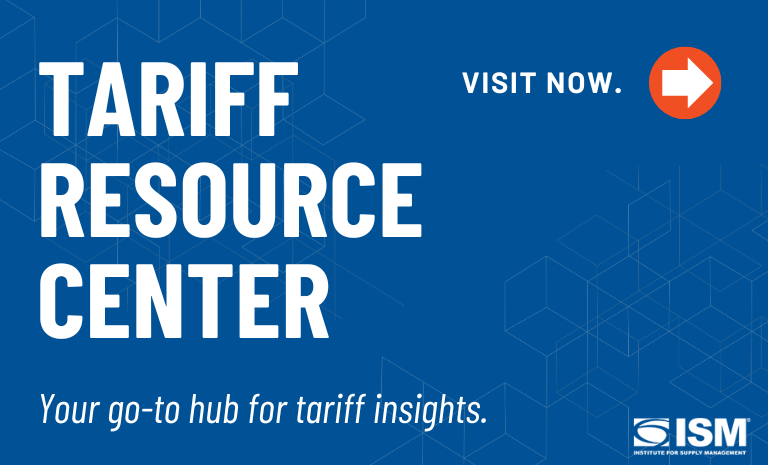Supply Chain Roundtable: Submitting an RFT (Request for Thanks)

Amid the gales of November and other challenging winter weather, supply chains and those that staff them must be especially diligent and resilient. But it’s also the time of the year to reflect on positive developments.
The roundtable of experts from Institute for Supply Management® (ISM®) discusses what procurement organizations can be thankful for, even with continuing uncertainty on such issues as tariffs and if/when to reshore. One of those blessings: Supply chain work is generally safer, thanks in part to the response to a maritime disaster taking place 50 years ago this month.
And that’s where this month’s panel — Thomas W. Derry, ISM CEO; Michelle Rohlwing, MBA, Manager, Product Development, Innovation and Learning; and Linda Aaron, MBA, Subject Matter Expert — will start.
Q: Amid the 50th anniversary of the Edmund Fitzgerald tragedy, the 29 men on board didn’t perish in vain — regulations and improved technologies in the aftermath made Great Lakes shipping much more efficient and safer. What are notable supply chain safety advancement(s) during your career? Did one benefit you and/or your team?
Aaron: Leaders of yesterday would have marveled at today’s tools. Imagine navigating storms without real-time visibility, predictive analytics or automated alerts. Decisions were based on instinct and delayed information. These innovations could have saved lives and safeguarded operations. Today, supply chain leaders can leverage (1) Internet of Things (IoT) sensors for instant data, (2) artificial intelligence (AI)-driven modeling to anticipate disruptions and (3) digital compliance systems to uphold global standards. These tools build resilience, efficiency and confidence. The lesson is clear: technology is not optional; it is a strategic advantage. Leaders who embrace it protect teams, strengthen partnerships and deliver value even in volatile times.
Derry: There’s also one that got away: Electronic logging devices (ELD) became mandatory for nearly all over-the-road trucks in the U.S. in 2017. The idea behind the requirement was to strictly enforce drivers’ hours of service, which would lead to less driver fatigue and fewer accidents. But in an interesting case of the law of unintended consequences, a study published in the Journal of Operations Management found that accidents actually increased after ELD implementation, with one hypothesis being drivers driving faster to compress their routes into the allotted 14 hours of service per day.
Rohlwing: Workplace stretching to reduce repetitive injuries emerged in the U.S. in the 1980s, but I didn't see it myself in the workplace until the early 2000s. This is definitely a great strategy to mitigate musculoskeletal injuries that often occur in industrial settings. It may seem small, but anyone with a wrist or shoulder injury knows it can impact your quality of life. I still get up from my desk and stretch on occasion, and I really feel the difference.
Q: The November/December issue of Inside Supply Management® includes a feature article, “The Mixed Reshoring Bag,” that details a chicken-and-egg conundrum for many companies — they want to source closer to home, but current consumer demand doesn’t justify the investment or higher U.S. labor costs. So, what’s the best approach for companies to reshore?
Rohlwing: I don't think reshoring is about taking a big leap but about being as strategic as possible and taking smart small steps. Reshoring critical components/products can be advantageous, but it may be more beneficial to nearshore or invest in automation to offset labor costs. It is always a balance of cost, risk and demand.
Derry: ISM® PMI® Reports data suggests that the path of least tariff resistance is more often found through other countries as opposed to reshoring to the U.S. Mexico continues to be a popular destination for relocating manufacturing, especially if goods are tariff-free under the U.S.-Mexico-Canada Agreement. And although tariff policy remains very fluid, evidence suggests manufacturing is shifting to other third countries subject to lower tariffs than the original home country.
Q: Speaking of the new magazine issue, Linda wrote an Insights column on the impact of fractional supply chain executives — temporary leadership, she stresses, but not temporary results. Have you experienced fractional leadership in your career? What were the benefits?
Derry: I have experienced fractional leaders in both IT and finance in my career. In my experience, which may be different from Linda’s, these executives had a short-term, transactional perspective — what tasks and projects must get done by when — and less of a long-term focus on strategic transformation.
Rohlwing: I have never experienced personally fractional leadership. However, I can see the advantage of being able to tap into seasoned professionals with deep experience for a short amount of time, as long as the cultures of the professional and the company align.
Q: This question is not exactly a curveball for November: What should supply managers be thankful for?
Rohlwing: Supply managers have a lot to be thankful for this year. Global disruptions have shown how critical these roles are to the success of a business. These used to be behind-the-scenes roles that are now being pushed into the spotlight. This is a competitive advantage for people in these types of positions.
Aaron: As a supply chain leader, I have much to be thankful for this season. Technology and innovation, from AI to automation, are transforming supply chains and enabling predictive insights and smarter decisions in real time. Data has become our compass, elevating supply management from transactional to strategic, helping us anticipate demand and mitigate risk. Partnerships remain our foundation, fostering resilience and collaboration when challenges arise. We are also grateful for the growing momentum behind sustainability, which better reflects our values and meets stakeholder expectations. Finally, the spirit of continuous learning keeps us adaptable and future-ready, embracing innovation with confidence. Together, these forces empower us to lead with purpose and integrity in an ever-changing world.
Derry: I suppose the silver lining in the turbulent world that is supply management these days is that the work we do is recognized and appreciated for keeping companies running, employees working and customers buying. To borrow a tagline from Home Depot, supply chains are “where doers get more done.”

